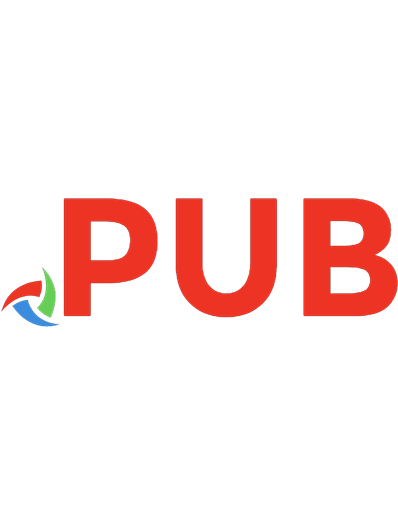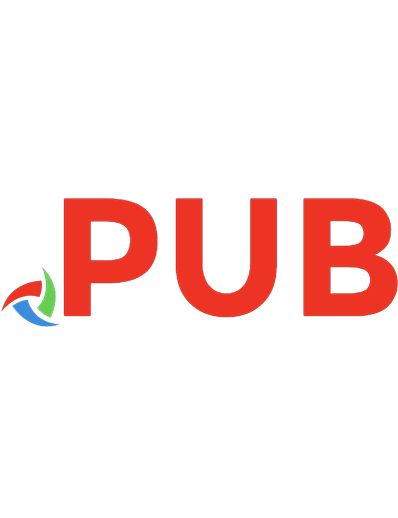Causal Inference and Discovery in Python: Unlock the secrets of modern causal machine learning with DoWhy, EconML, PyTorch and more 1804612987, 9781804612989
Demystify causal inference and casual discovery by uncovering causal principles and merging them with powerful machine l
769 142 10MB
English Pages 456 Year 2023
Table of contents :
Cover
Title Page
Copyright and Credit
Dedicated
Foreword
Contributors
Acknowledgments
Table of Contents
Preface
Part 1: Causality – an Introduction
Chapter 1: Causality – Hey, We Have Machine Learning, So Why Even Bother?
A brief history of causality
Why causality? Ask babies!
Interacting with the world
Confounding – relationships that are not real
How not to lose money… and human lives
A marketer’s dilemma
Let’s play doctor!
Associations in the wild
Wrapping it up
References
Chapter 2: Judea Pearl and the Ladder of Causation
From associations to logic and imagination – the Ladder of Causation
Associations
Let’s practice!
What are interventions?
Changing the world
Correlation and causation
What are counterfactuals?
Let’s get weird (but formal)!
The fundamental problem of causal inference
Computing counterfactuals
Time to code!
Extra – is all machine learning causally the same?
Causality and reinforcement learning
Causality and semi-supervised and unsupervised learning
Wrapping it up
References
Chapter 3: Regression, Observations, and Interventions
Starting simple – observational data and linear regression
Linear regression
p-values and statistical significance
Geometric interpretation of linear regression
Reversing the order
Should we always control for all available covariates?
Navigating the maze
If you don’t know where you’re going, you might end up somewhere else
Get involved!
To control or not to control?
Regression and structural models
SCMs
Linear regression versus SCMs
Finding the link
Regression and causal effects
Wrapping it up
References
Chapter 4: Graphical Models
Graphs, graphs, graphs
Types of graphs
Graph representations
Graphs in Python
What is a graphical model?
DAG your pardon? Directed acyclic graphs in the causal wonderland
Definitions of causality
DAGs and causality
Let’s get formal!
Limitations of DAGs
Sources of causal graphs in the real world
Causal discovery
Expert knowledge
Combining causal discovery and expert knowledge
Extra – is there causality beyond DAGs?
Dynamical systems
Cyclic SCMs
Wrapping it up
References
Chapter 5: Forks, Chains, and Immoralities
Graphs and distributions and how to map between them
How to talk about independence
Choosing the right direction
Conditions and assumptions
Chains, forks, and colliders or…immoralities
A chain of events
Chains
Forks
Colliders, immoralities, or v-structures
Ambiguous cases
Forks, chains, colliders, and regression
Generating the chain dataset
Generating the fork dataset
Generating the collider dataset
Fitting the regression models
Wrapping it up
References
Part 2: Causal Inference
Chapter 6: Nodes, Edges, and Statistical (In)dependence
You’re gonna keep ‘em d-separated
Practice makes perfect – d-separation
Estimand first!
We live in a world of estimators
So, what is an estimand?
The back-door criterion
What is the back-door criterion?
Back-door and equivalent estimands
The front-door criterion
Can GPS lead us astray?
London cabbies and the magic pebble
Opening the front door
Three simple steps toward the front door
Front-door in practice
Are there other criteria out there? Let’s do-calculus!
The three rules of do-calculus
Instrumental variables
Wrapping it up
Answer
References
Chapter 7: The Four-Step Process of Causal Inference
Introduction to DoWhy and EconML
Python causal ecosystem
Why DoWhy?
Oui, mon ami, but what is DoWhy?
How about EconML?
Step 1 – modeling the problem
Creating the graph
Building a CausalModel object
Step 2 – identifying the estimand(s)
Step 3 – obtaining estimates
Step 4 – where’s my validation set? Refutation tests
How to validate causal models
Introduction to refutation tests
Full example
Step 1 – encode the assumptions
Step 2 – getting the estimand
Step 3 – estimate!
Step 4 – refute them!
Wrapping it up
References
Chapter 8: Causal Models – Assumptions and Challenges
I am the king of the world! But am I?
In between
Identifiability
Lack of causal graphs
Not enough data
Unverifiable assumptions
An elephant in the room – hopeful or hopeless?
Let’s eat the elephant
Positivity
Exchangeability
Exchangeable subjects
Exchangeability versus confounding
…and more
Modularity
SUTVA
Consistency
Call me names – spurious relationships in the wild
Names, names, names
Should I ask you or someone who’s not here?
DAG them!
More selection bias
Wrapping it up
References
Chapter 9: Causal Inference and Machine Learning – from Matching to Meta-Learners
The basics I – matching
Types of matching
Treatment effects – ATE versus ATT/ATC
Matching estimators
Implementing matching
The basics II – propensity scores
Matching in the wild
Reducing the dimensionality with propensity scores
Propensity score matching (PSM)
Inverse probability weighting (IPW)
Many faces of propensity scores
Formalizing IPW
Implementing IPW
IPW – practical considerations
S-Learner – the Lone Ranger
The devil’s in the detail
Mom, Dad, meet CATE
Jokes aside, say hi to the heterogeneous crowd
Waving the assumptions flag
You’re the only one – modeling with S-Learner
Small data
S-Learner’s vulnerabilities
T-Learner – together we can do more
Forcing the split on treatment
T-Learner in four steps and a formula
Implementing T-Learner
X-Learner – a step further
Squeezing the lemon
Reconstructing the X-Learner
X-Learner – an alternative formulation
Implementing X-Learner
Wrapping it up
References
Chapter 10: Causal Inference and Machine Learning – Advanced Estimators, Experiments, Evaluations, and More
Doubly robust methods – let’s get more!
Do we need another thing?
Doubly robust is not equal to bulletproof…
…but it can bring a lot of value
The secret doubly robust sauce
Doubly robust estimator versus assumptions
DR-Learner – crossing the chasm
DR-Learners – more options
Targeted maximum likelihood estimator
If machine learning is cool, how about double machine learning?
Why DML and what’s so double about it?
DML with DoWhy and EconML
Hyperparameter tuning with DoWhy and EconML
Is DML a golden bullet?
Doubly robust versus DML
What’s in it for me?
Causal Forests and more
Causal trees
Forests overflow
Advantages of Causal Forests
Causal Forest with DoWhy and EconML
Heterogeneous treatment effects with experimental data – the uplift odyssey
The data
Choosing the framework
We don’t know half of the story
Kevin’s challenge
Opening the toolbox
Uplift models and performance
Other metrics for continuous outcomes with multiple treatments
Confidence intervals
Kevin’s challenge’s winning submission
When should we use CATE estimators for experimental data?
Model selection – a simplified guide
Extra – counterfactual explanations
Bad faith or tech that does not know?
Wrapping it up
References
Chapter 11: Causal Inference and Machine Learning – Deep Learning, NLP, and Beyond
Going deeper – deep learning for heterogeneous treatment effects
CATE goes deeper
SNet
Transformers and causal inference
The theory of meaning in five paragraphs
Making computers understand language
From philosophy to Python code
LLMs and causality
The three scenarios
CausalBert
Causality and time series – when an econometrician goes Bayesian
Quasi-experiments
Twitter acquisition and our googling patterns
The logic of synthetic controls
A visual introduction to the logic of synthetic controls
Starting with the data
Synthetic controls in code
Challenges
Wrapping it up
References
Part 3: Causal Discovery
Chapter 12: Can I Have a Causal Graph, Please?
Sources of causal knowledge
You and I, oversaturated
The power of a surprise
Scientific insights
The logic of science
Hypotheses are a species
One logic, many ways
Controlled experiments
Randomized controlled trials (RCTs)
From experiments to graphs
Simulations
Personal experience and domain knowledge
Personal experiences
Domain knowledge
Causal structure learning
Wrapping it up
References
Chapter 13: Causal Discovery and Machine Learning – from Assumptions to Applications
Causal discovery – assumptions refresher
Gearing up
Always trying to be faithful…
…but it’s difficult sometimes
Minimalism is a virtue
The four (and a half) families
The four streams
Introduction to gCastle
Hello, gCastle!
Synthetic data in gCastle
Fitting your first causal discovery model
Visualizing the model
Model evaluation metrics
Constraint-based causal discovery
Constraints and independence
Leveraging the independence structure to recover the graph
PC algorithm – hidden challenges
PC algorithm for categorical data
Score-based causal discovery
Tabula rasa – starting fresh
GES – scoring
GES in gCastle
Functional causal discovery
The blessings of asymmetry
ANM model
Assessing independence
LiNGAM time
Gradient-based causal discovery
What exactly is so gradient about you?
Shed no tears
GOLEMs don’t cry
The comparison
Encoding expert knowledge
What is expert knowledge?
Expert knowledge in gCastle
Wrapping it up
References
Chapter 14: Causal Discovery and Machine Learning – Advanced Deep Learning and Beyond
Advanced causal discovery with deep learning
From generative models to causality
Looking back to learn who you are
DECI’s internal building blocks
DECI in code
DECI is end-to-end
Causal discovery under hidden confounding
The FCI algorithm
Other approaches to confounded data
Extra – going beyond observations
ENCO
ABCI
Causal discovery – real-world applications, challenges, and open problems
Wrapping it up!
References
Chapter 15: Epilogue
What we’ve learned in this book
Five steps to get the best out of your causal project
Starting with a question
Obtaining expert knowledge
Generating hypothetical graph(s)
Check identifiability
Falsifying hypotheses
Causality and business
How causal doers go from vision to implementation
Toward the future of causal ML
Where are we now and where are we heading?
Causal benchmarks
Causal data fusion
Intervening agents
Causal structure learning
Imitation learning
Learning causality
Let’s stay in touch
Wrapping it up
References
Index
Other Books You May Enjoy

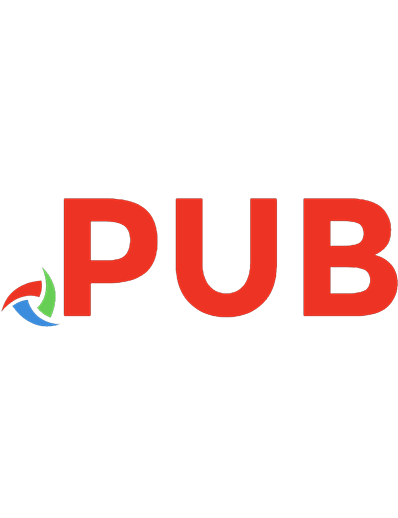


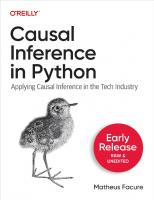
![Causal Inference in Python: Applying Causal Inference in the Tech Industry [1 ed.]
1098140257, 9781098140250](https://dokumen.pub/img/200x200/causal-inference-in-python-applying-causal-inference-in-the-tech-industry-1nbsped-1098140257-9781098140250.jpg)

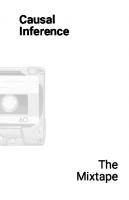
![Causal Inference in Python: Applying Causal Inference in the Tech Industry (Fourth Early Release) [4 ed.]
9781098140250, 9781098140199](https://dokumen.pub/img/200x200/causal-inference-in-python-applying-causal-inference-in-the-tech-industry-fourth-early-release-4nbsped-9781098140250-9781098140199.jpg)
